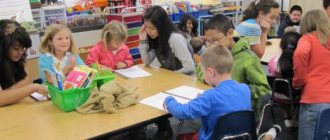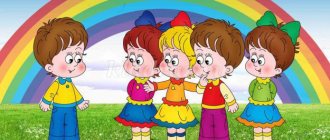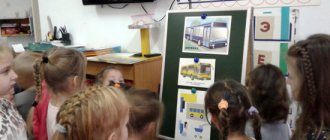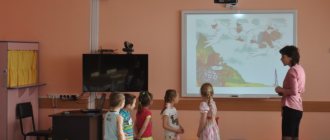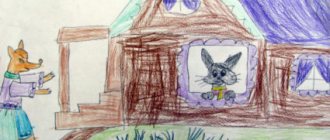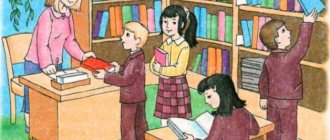Work program for the Rainbow program, senior group.
the child is capable of volitional efforts, can follow social norms of behavior and rules in various types of activities, in relationships with
adults and peers, can follow the rules of safe behavior and personal hygiene;
the child shows curiosity, asks questions to adults and peers, is interested in cause-and-effect relationships, and tries to independently come up with explanations for natural phenomena and people’s actions; inclined to observe and experiment. Has basic knowledge about himself, about the natural and social world in which he lives; is familiar with works of children's literature, has basic understanding of wildlife, natural science, mathematics, history, etc.; the child is capable of making his own decisions, relying on his knowledge and skills in various activities.
Based on the results of mastering the Rainbow Program, the child:
has physical development corresponding to age normative indicators; he has developed basic physical qualities, the need for physical activity and movement; shows individual interest in some form of physical activity (sports, choreography);
has basic cultural and hygienic skills; implements them independently and consciously in his life;
understands and shares the value of a healthy lifestyle, knows how to follow basic rules for protecting one’s own health and the health of others, has an age-appropriate understanding of safe behavior in everyday life, in nature, among strangers; cognitively active, inquisitive, able to independently research, experiment, find a variety of information in various sources - books, encyclopedias, films, and also knows how to ask adults questions of interest; has its own area of interest;
is independent and at the same time knows how to turn to adults for help;
interested in learning and improving one’s own competence in various fields of activity, has the universal prerequisites for educational activities: the ability to work according to rules and patterns, listen to an adult and follow his instructions;
emotionally responsive, capable of empathy and sympathy, responds to the emotions of loved ones, empathizes with characters when perceiving works of fiction, theater, cinema, visual arts, music, as well as the beauty of the surrounding world, nature;
sociable, able to adequately use verbal and non-verbal means of communication, able to conduct a dialogue and express his thoughts using monologue speech; knows how to negotiate with peers, plan joint activities, has cooperation skills; has a communication style with adults and peers and can change it at will;
Senior group. Senior preschool age. Children 5-6 years old
Open final integrated lesson in the senior group “In Search of the Rainbow” Open final integrated lesson in the senior group “In Search of the Rainbow ”
Goal: Consolidation of previously studied material.
Objectives: 1. Educational: continue to form mental operations (analysis, synthesis, generalization, classification)
2. Developmental: develop speech, mental…
Abstract of an educational activity on application in the senior group “Multi-colored rainbow” Abstract of an educational activity on application in the senior group “Multi-colored rainbow ” Purpose: To consolidate children’s skills in creating a three-dimensional application. Objectives: - To develop the ability to compose a composition on a sheet of paper; — develop cognitive activity, fine motor skills of the hands; - contribute…
Thematic lesson “7 colors of the rainbow”
04/15/2015, Ready-made lessons on speech development, Commentary articles 4
Hello, dear friends! Today we invite you to get acquainted with an amazing natural phenomenon - a rainbow. Where does it come from, why is it multi-colored, is a rainbow round? We invite you to go for a walk along the rainbow together, where our little “whys” will learn a lot of new and interesting things not only about the rainbow, learn the names of the 7 colors of the rainbow, but also discover the wonders and secrets of color and even conduct their own scientific experiment.
Watch a presentation about rainbows with your child. After watching, remember when you saw a rainbow, ask your child to tell what the weather was like then, how he remembered the rainbow. Learn the poems you like.
You will find a link to download materials for the thematic lesson “7 Colors of the Rainbow” at the end of the article.
Game “Color Song”
Goal: development of musical ear and motor activity.
What you will need: music, song lyrics and a good mood.
How to play: turn on the music and dance with your child as you like.
Game “Flower Shop”
Goal: development of physiological breathing
How to play: Tell your child: “Imagine that we went to a flower shop. They sell many, many wonderful flowers there. The air is filled with aromas. Let's breathe in these aromas and try to guess what kind of flower smells so delicious.
Inhale slowly and deeply. Try to feel the aroma of flowers flowing through your dilated nostrils. The chest is expanded, the shoulders are lowered. Holding your breath (looking for the aroma). Exhale smoothly. Can be repeated 2-3 times.
Game “Walk on the Rainbow. Labyrinth”
Goal: training attention and perseverance, developing fine motor skills.
What you will need: a printed picture of a labyrinth, a pencil/pen.
How to play: invite your child to walk along the rainbow, passing through an intricate maze. A small child can trace the labyrinth with his finger; older children can be asked to draw a path through the labyrinth with a pencil.
Game “Edible paints”
Goal: development of creative imagination, ability to think outside the box, training of visual perception.
What you will need: ketchup, tomato, beets, herbs (parsley/dill, basil, etc.), berries (strawberries/raspberries, currants, chokeberries, you can also use frozen berries), chocolate, a sheet of thick paper.
How to play: prepare vegetables and berries for the lesson in advance (wash, peel, cut the beets if necessary).
Ask your child: “What can you use to draw with?” Most likely, the most popular answer will be: pencils/paints/markers/pens. Say, “That's right. Do you want to paint with paints that you can even eat? There are vegetables and fruits in nature that can draw.” Invite your child to take turns painting with our natural edible paints. Say the name of the vegetable or berry, discuss what color each vegetable produces. When the painting made from edible paints is ready, you can discuss with older children where paints come from and what they are made from.
Game “Color Poems”
Goal: consolidate the names of colors, memory training.
What you will need: printed poems by Sofia Bulanova “Colors” (sheet 1, sheet 2)
Game “Name the Color”
Goal: development of imagination, expansion of vocabulary.
What you will need: a ball. How to play:
for children from 4-5 years old: you name a color, and the child names objects of this color. For example, “green,” and the child answers: “cucumber, grass, grasshopper,” yellow – sun, dandelion, chicken. etc.
for kids: You throw the ball to the baby, name the object, and the child throws the ball back and names the color of this object. For example, the sun is yellow, orange is orange. If your baby doesn’t know colors yet, then help him by naming the colors yourself.
Game "Mosaic Application"
Goal: creating an application, developing fine motor skills and aesthetic taste
What you will need: • a sheet of cardboard • a simple pencil • colored paper • safety scissors • glue
How to play:
The game can be divided into three stages, which can be played both together and at different times.
Stage 1. Young artist. Discuss with your child what he would like to draw. Draw the selected picture with a simple pencil on a sheet of cardboard (older children will be able to cope with the task on their own).
Stage 2. Diligent scissors. You need to prepare pieces of paper. Kids usually love cutting paper. Therefore, look at the age and desire of the baby: you can prepare the “mosaic” yourself, you can entrust it to your child, or you can do it together. Pieces can be of any size and shape. The only condition: you need to make sure that the pieces are not too large for laying out the drawn objects.
Stage 3. Let's create a masterpiece. Cover the prepared drawing with pieces of colored paper.
Game “Magic Milk”
Goal: development of imagination, fantasy, ability to think, analyze, develop cognitive interest.
What you will need: a plate, milk (fat content of at least 2.5%), a cotton swab, egg coloring (or other food coloring), any liquid dishwashing detergent.
How to play: If the baby is very small, then prepare everything in advance. However, from the age of 2, all preparation can be carried out with the child. Ask him to pour milk into a plate. Pour coloring into different parts of the plate. Comment on all actions, name the color of the dye you add. Pay attention to the child that if you do not touch the milk, the colors will not mix yet. When all the dyes have been added, give your child a cotton swab, dip it in the detergent and touch the stick to the milk. The colors will mix. Observe the process. If the baby likes it, give him room for imagination and action. Let him try again by pouring a drop of detergent into the milk. You can mix and see what color you end up with. Discuss the experiment you did.
All materials for the thematic lesson “7 Colors of the Rainbow” can be downloaded here.
That's all for today! Have fun playing!
Yours Alena Volkova and Anna Voronina.
Even more interesting games in the new themed week “Colorful Week”
A colorful week is 7 fun days with useful educational games dedicated to the secrets of color.
These are poems and interesting tales, amazing experiences and experiments.
All the details of the Colorful Week are here!
Along the paths of the rainbow
Abstract of GCD on the formation of elementary mathematical concepts in the senior group
Target
: generalization and consolidation of knowledge among children of the senior group on the topic of material for the school year.
Educational tasks
: consolidate quantitative and ordinal counting from 1 to 10 and back, understanding the number series;
consolidate skills in comparing the number of objects; consolidate the ability to navigate on a sheet of paper; continue to form an idea of the table. Developmental tasks
: train mental operations;
develop spatial and logical thinking, attention, speech, curiosity, emotions, interest in independently solving problem situations. Educational objectives
: to cultivate mutual assistance, independence, determination, perseverance.
Materials and equipment
: projector, presentation, ball, easel, paper flowers with tasks, cards with numbers, geometric bodies (cube, ball, prism, cone, pyramid, parallelepiped, cylinder);
white dish, Skittles candies, warm water for experiment, musical accompaniment: “Rainbow Song” lyrics. and music T. Shikalova. Handouts
: cards for comparing numbers, cards with passports of geometric bodies, a set of numbers, table cards, geometric shapes (3 blue triangles, 3 pink squares, 3 green circles).
Progress of activities
Educator
: Guys, can you solve riddles?
Children
: Yes.
Educator
: Then listen carefully.
The rain is over. Having parted the clouds, a ray of sunshine made its way to us. And literally before our eyes, the Bridge appeared in heaven. Multi-colored arc - This is... ( Rainbow
.)
Look at the screen. What a beauty! What could be brighter than a rainbow?
What a miracle, miracles. The rainbow came to visit, And brought paths. And the paths are not simple. They are all magical, colorful. Whoever walks along the paths will move on to the preparatory group!
Guys, do you want to go to the preparatory group?
Children
: Yes.
Educator
: Oh, what happened?
The rainbow has disappeared! How do we now move on to the preparatory group? Where did she disappear to? ( Children's answers
.) I wonder if there is some secret here?
Look carefully at the screen! I think I guessed where the rainbow hid! And you?! ( Children's answers. The teacher draws the children's attention to the flowers growing in the clearing
.) In order for the rainbow to appear again, you need to complete math assignments.
They will be very difficult. So guys, be careful! Ready? ( Yes
.) Let's try.
Remember how many colors are in the rainbow? Name them. ( Children's answers
.) They all stand next to each other in strict order. Which flower will we pick first?
Children
: Red.
( The game exercise “Match the numbers” is carried out
.)
Educator
: A strange case, a rare case, Numbers in a quarrel, Here they are! Not one of them wants to stand with their neighbor, We need to reconcile the numbers. And restore their order"
How can you reconcile the numbers? What needs to be done to get them in the right order? ( Children's answers
.) That's right, you need to build a number series from 1 to 10. Take the numbers lying on the table and put them in the correct order.
Well done guys, you completed the task and we have our first rainbow carpet - red. ( A rainbow path appears on the screen
.) What color will the next flower be?
Children
: Orange.
( The game exercise “Name the neighbors of the numbers” is being carried out. The teacher shows cards with numbers.
) Well done, guys, and you did an excellent job with this task.
And we have another track - orange. ( A rainbow path appears on the screen
.) The next flower will be...?
Children
: Yellow.
( A ball game is played in the “Days of the Week” circle. The teacher asks questions
.)
Educator
: How many days are there in a week?
List the days of the week in order. What days are days off? Name the day of the week before Wednesday. Name the day of the week between Thursday and Saturday. What day of the week is it today? ( Children's answers.
) Everyone completed the task and we got another path - yellow.
Choose the next flower. What color is it? ( Children’s answers. The game exercise “More - less - equal” is carried out.
) Compare the number of objects using the signs “<”, “>”, “=”.
Now we will work in pairs. ( Children complete the task.
) Great! Another rainbow path has appeared. What color will the next flower be?
Children
: Blue.
Educator
: That's right (
working at tables in pairs
). Guys, come to the table. What's on the table?
Children
: Figures.
( A game exercise is carried out in pairs “I lost my passport
.”)
Educator
: Let's remember their names.
( Children's answers
.) These figures lost their passports.
But how can we help them? Choose one figure for yourself. The remaining figure will be mine. Listen to the hint. I'll take a card and a piece. Since this figure is three-dimensional, I will look at it from all sides. What does this figure look like from the side? Above? From below? ( Children's answers
.) Let's now try to find her passport among others.
When you find the passport, place the figure on it. Hooray! We now have a fifth blue track. ( Physical minutes are held with musical accompaniment.
) How many flowers are left in the clearing?
What color will the next flower be? ( Children's answers. In the next task, the teacher orally pronounces the text of the problem
.)
The hedgehog brought three apples from the garden. He gave the most rosy thing to Belka. The squirrel happily received the gift. Count the apples on the hedgehog's plate. ( Children count and name the answer. The teacher says the next problem
.)
Well done boys! All problems were solved correctly. Our rainbow is getting wider and brighter! A blue path has appeared! We have one last flower left. Which?
Children
: Violet.
( Game exercise “Fill in the table
.”)
Educator:
You have geometric figures and a table on your tables.
You need to fill out the table correctly. Listen carefully. Place a blue triangle in the upper left corner. Place a blue triangle in the center of the table. Now fill in the empty cells with figures so that they are not repeated either in the rows or in the columns. Happened? Let's check. Well done boys! The last path of the rainbow appeared - purple. Look how the rainbow is shining again! For your efforts, I have prepared a small surprise. ( Finally, a Rainbow experiment is performed using Skittles and water
.)
Lyubov Bukhalova, teacher
at MBDOU “Kindergarten No. 251”, Barnaul, Altai Territory
